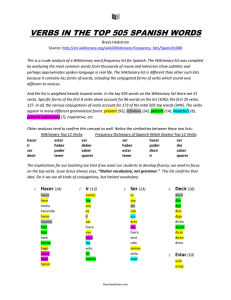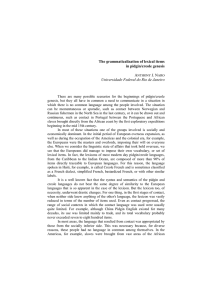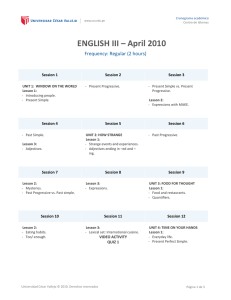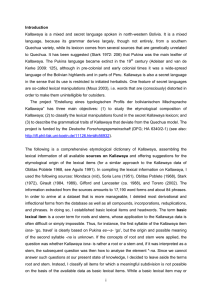From GLÀFF to PsychoGLÀFF: a large psycholinguistics
Anuncio
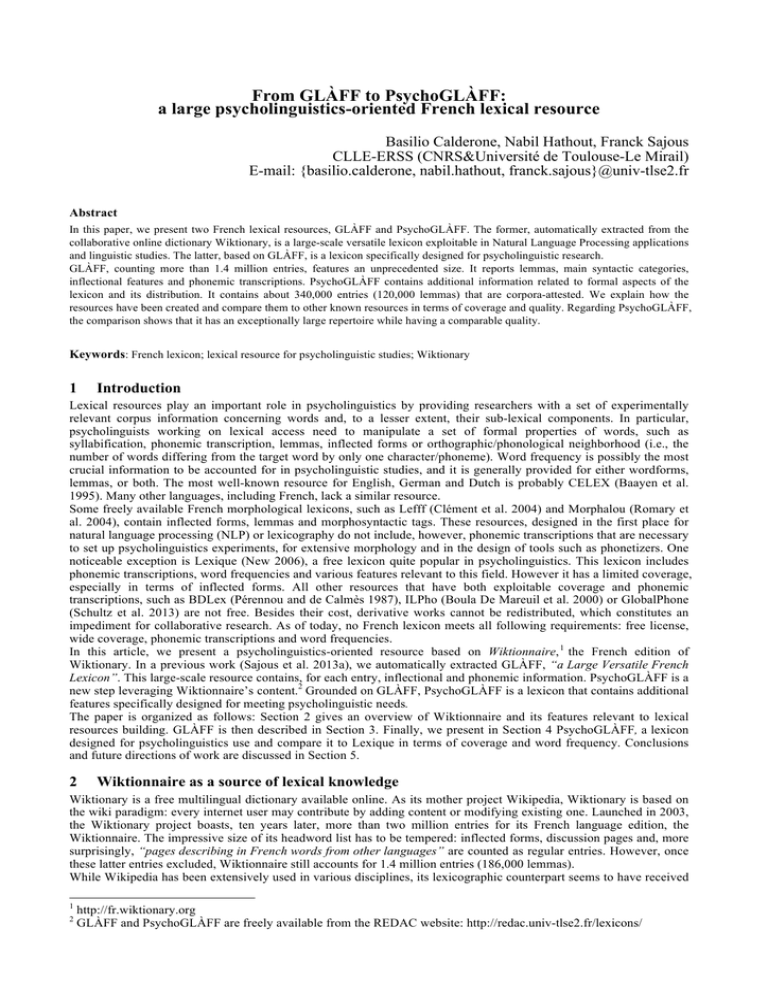
From GLÀFF to PsychoGLÀFF:
a large psycholinguistics-oriented French lexical resource
Basilio Calderone, Nabil Hathout, Franck Sajous
CLLE-ERSS (CNRS&Université de Toulouse-Le Mirail)
E-mail: {basilio.calderone, nabil.hathout, franck.sajous}@univ-tlse2.fr
Abstract
In this paper, we present two French lexical resources, GLÀFF and PsychoGLÀFF. The former, automatically extracted from the
collaborative online dictionary Wiktionary, is a large-scale versatile lexicon exploitable in Natural Language Processing applications
and linguistic studies. The latter, based on GLÀFF, is a lexicon specifically designed for psycholinguistic research.
GLÀFF, counting more than 1.4 million entries, features an unprecedented size. It reports lemmas, main syntactic categories,
inflectional features and phonemic transcriptions. PsychoGLÀFF contains additional information related to formal aspects of the
lexicon and its distribution. It contains about 340,000 entries (120,000 lemmas) that are corpora-attested. We explain how the
resources have been created and compare them to other known resources in terms of coverage and quality. Regarding PsychoGLÀFF,
the comparison shows that it has an exceptionally large repertoire while having a comparable quality.
Keywords: French lexicon; lexical resource for psycholinguistic studies; Wiktionary
1
Introduction
Lexical resources play an important role in psycholinguistics by providing researchers with a set of experimentally
relevant corpus information concerning words and, to a lesser extent, their sub-lexical components. In particular,
psycholinguists working on lexical access need to manipulate a set of formal properties of words, such as
syllabification, phonemic transcription, lemmas, inflected forms or orthographic/phonological neighborhood (i.e., the
number of words differing from the target word by only one character/phoneme). Word frequency is possibly the most
crucial information to be accounted for in psycholinguistic studies, and it is generally provided for either wordforms,
lemmas, or both. The most well-known resource for English, German and Dutch is probably CELEX (Baayen et al.
1995). Many other languages, including French, lack a similar resource.
Some freely available French morphological lexicons, such as Lefff (Clément et al. 2004) and Morphalou (Romary et
al. 2004), contain inflected forms, lemmas and morphosyntactic tags. These resources, designed in the first place for
natural language processing (NLP) or lexicography do not include, however, phonemic transcriptions that are necessary
to set up psycholinguistics experiments, for extensive morphology and in the design of tools such as phonetizers. One
noticeable exception is Lexique (New 2006), a free lexicon quite popular in psycholinguistics. This lexicon includes
phonemic transcriptions, word frequencies and various features relevant to this field. However it has a limited coverage,
especially in terms of inflected forms. All other resources that have both exploitable coverage and phonemic
transcriptions, such as BDLex (Pérennou and de Calmès 1987), ILPho (Boula De Mareuil et al. 2000) or GlobalPhone
(Schultz et al. 2013) are not free. Besides their cost, derivative works cannot be redistributed, which constitutes an
impediment for collaborative research. As of today, no French lexicon meets all following requirements: free license,
wide coverage, phonemic transcriptions and word frequencies.
In this article, we present a psycholinguistics-oriented resource based on Wiktionnaire, 1 the French edition of
Wiktionary. In a previous work (Sajous et al. 2013a), we automatically extracted GLÀFF, “a Large Versatile French
Lexicon”. This large-scale resource contains, for each entry, inflectional and phonemic information. PsychoGLÀFF is a
new step leveraging Wiktionnaire’s content.2 Grounded on GLÀFF, PsychoGLÀFF is a lexicon that contains additional
features specifically designed for meeting psycholinguistic needs.
The paper is organized as follows: Section 2 gives an overview of Wiktionnaire and its features relevant to lexical
resources building. GLÀFF is then described in Section 3. Finally, we present in Section 4 PsychoGLÀFF, a lexicon
designed for psycholinguistics use and compare it to Lexique in terms of coverage and word frequency. Conclusions
and future directions of work are discussed in Section 5.
2
Wiktionnaire as a source of lexical knowledge
Wiktionary is a free multilingual dictionary available online. As its mother project Wikipedia, Wiktionary is based on
the wiki paradigm: every internet user may contribute by adding content or modifying existing one. Launched in 2003,
the Wiktionary project boasts, ten years later, more than two million entries for its French language edition, the
Wiktionnaire. The impressive size of its headword list has to be tempered: inflected forms, discussion pages and, more
surprisingly, “pages describing in French words from other languages” are counted as regular entries. However, once
these latter entries excluded, Wiktionnaire still accounts for 1.4 million entries (186,000 lemmas).
While Wikipedia has been extensively used in various disciplines, its lexicographic counterpart seems to have received
1
2
http://fr.wiktionary.org
GLÀFF and PsychoGLÀFF are freely available from the REDAC website: http://redac.univ-tlse2.fr/lexicons/
less attention from the scientific community. Wiktionary was first used in NLP by Zesch et al. (2008) to compute
semantic relatedness. Its potential as an electronic lexicon was studied for the first time by Navarro et al. (2009) for
French and English synonymy mining. Along the same line of research, Anton Perez et al. (2011) realized the
integration of the Portuguese edition of Wiktionary in the ontology Onto.PT (Gonçalo Oliveira and Gomes 2010).
Serasset (2012) designed Dbnary, an open-source resource containing “easily extractable entries”. The French subpart
of this resource contains 260,467 entries. Works led by Meyer and Gurevych (2012) and Gurevych et al. (2012)
resulted in German and English ontologies based on Wiktionary. Sajous et al. (2010) has made available a structured
XML version of this lexicon for French and English, called WiktionaryX.3
Although Wiktionnaire presents interesting features (unprecedented coverage, definitions, phonemic transcriptions,
semantic relations, translations, free license),4 the information it contains is difficult to extract. This probably explains
the relatively small number of works using it. Wiktionnaire, as other Wiktionary’s language editions, is released as an
“XML dump”, where XML only marks the macrostructure. The microstructure is encoded in a format called wikicode,
inherent in the content management system MediaWiki. This format has no formally defined syntax, evolves over time,
and is not stable from one language edition to another. This underspecified syntax makes therefore the automatic
information extraction from the collaborative dictionary uneasy: multiple deviations from a “prototypical article”
should be expected, as well as missing information, redundancy and inconsistency.
Figure 1 shows the entry affluent (adjective and noun ‘affluent’, and two inflection forms of the verb affluer ‘to flow
into/to pour in’) as it is visible in Wiktionnaire. The corresponding wikicode of this article is shown in Figure 2.
Inflected forms may appear in the article related to their lemma (as it is the case in Figure 1). They may also have a
dedicated page (cf. Figures 3 and 4).
Figure 1: Article of the word ‘affluent’ in Wiktionnaire
The table of the adjective inflected forms (top-right in Figure 1) is not explicitly present in the wikicode, but is
generated by the template {{fr-accord-cons|a.fly.ɑ̃|t}} (cf. Figure 2). There are hundreds of similar patterns in
the wikicode. An example of the non-systematic wikicode’s format and resulting article’s layout can be seen in
Figure 3: unlike the template {{f}} that defines the feminine gender of the form, there is no template specifying the
grammatical number. The number can only be extracted by parsing the definition “Féminin singulier”. The
heterogeneity of the wikicode also concerns the phonemic transcriptions: they occur sometimes in the Ligne de forme
(the line following the part of speech heading), as in Figure 3 for ‘affluente’, and sometimes, on the contrary, they are
specified in a separate “Prononciation” section as in Figure 4 for ‘affluentes’.
To build GLÀFF and PsychoGLÀFF, we automatically extracted the inflected forms and lemmas in their dedicated
pages, and detected the inflection templates. We also identified the phonemic transcriptions wherever they occur. We
finally parsed the conjugation tables (cf. Figure 5). We thus collected as much (possibly redundant) information as
possible and applied some heuristics to automatically detect major inconsistencies.
3
WiktionaryX, is an XML version of the English and French editions of Wiktionary, freely available at
http://redac.univ-tlse2.fr/lexiques/wiktionaryx.html
4
For a more comprehensive description of the Wiktionnaire, see (Navarro et al. 2009) and (Sajous et al. 2010; 2013b).
Figure 2: Wikicode of the article ‘affluent’
Figure 3: Article and wikicode of ‘affluente’
Figure 4: Article and wikicode of ‘affluentes’
Figure 5. Conjugation table of the verb affluer (extract)
3
GLÀFF
In this section, we summarize some relevant characteristics of GLÀFF, first introduced in (Sajous et al. 2013a), from
which PsychoGLÀFF is derived. The latest version of GLÀFF includes nouns, verbs, adjectives, adverbs, and function
words. As can be seen in Figure 6, GLÀFF specifies for each entry:
•
•
•
•
the wordform;
the lemma;
the part of speech and morphosyntactic features in GRACE format (Rajman et al. 1997);
the phonological transcription(s) (when specified in Wiktionnaire) in IPA and in SAMPA with syllable
boundaries.
Figure 6: Extract of GLÀFF
3.1 Coverage
GLÀFF differs from the lexicons currently used in NLP and psycholinguistics by its exceptional size. Table 1 shows
the number of inflected forms and lemmas for simple words (only letters) and non-simple words (containing spaces,
dashes or digits) in five different French lexicons. GLÀFF contains from 3 to 4 times more tokens and from 3 to 9
times more inflected forms than the other lexicons.
Categorized inflected forms
Simple
Non simple
Categorized lemmas
Total
Simple
Non simple
Total
Lexique
147,912
4,696
152,608
46,649
3,770
50,419
BDLex
431,992
4,360
436,352
47,314
1,792
49,106
Lefff
466,668
3,829
470,497
54,214
2,303
56,517
Morphalou
524,179
49
524,228
65,170
7
65,177
1,401,578
24,270
1,425,848
172,616
13,466
186,082
GLÀFF
Table 1: Size of five French lexicons (counting only nouns, verbs, adjectives and adverbs).
Table 2 reports the intersection of GLÀFF with the other lexicons. We observe that the magnitude of the intersection
depends on the size of the lexicons: the bigger a lexicon, the larger its intersection with the other ones. Three groupings
emerge: Lexique has the smallest coverage, only containing 9% of GLÀFF and 22% to 26% of the entries of the other
lexicons. BDLex, Lefff and Morphalou cover 76% to 80% of Lexique and about 30% of GLÀFF. Finally GLÀFF is
clearly on top with coverage of 85% to 93%. In total, its coverage is 5% to 65% higher than the other lexicons.
Lexique
BDLex
Lefff
Morphalou
GLÀFF
-
26.03
25.20
22.46
8.95
BDLex
76.02
-
79.87
70.40
28.75
Lefff
79.50
86.28
-
72.32
30.04
Morphalou
79.58
85.43
81.24
-
32.03
GLÀFF
84.83
93.26
90.23
85.66
-
Lexique
Table 2: Intersection of five French lexicons (% of the categorized inflected forms).
Size is a crucial aspect of the lexicons used for research in derivational and inflectional morphology or, more generally,
in the development of NLP tools such as morphosyntactic taggers and parsers. In order to asses that GLÀFF’s largest
size is actually useful, we compared the five lexicons with the vocabulary of four corpora of various types. Frantext 20e
is constituted by 515 novels of 20th century French literature containing 30 million words. LM10 is a 200 million word
corpus made up of the archives of the newspaper Le Monde from 1991 to 2000. The third corpus, containing 260
million words, consists of the articles from the French Wikipedia. Finally, FrWaC (Baroni et al. 2009) is a 1.6 billion
words corpus of French web pages. Table 3 shows the coverage of the five lexicons with respect to the four corpora.
Threshold: frequency ≥
#forms
Lexique
BDLex
Frantext
Lefff
Morphalou
GLÀFF
#forms
Lexique
BDLex
LM10
Lefff
Morphalou
GLÀFF
#forms
Lexique
BDLex
Wikipedia
Lefff
Morphalou
GLÀFF
#forms
Lexique
BDLex
FrWaC
Lefff
Morphalou
GLÀFF
1
145,437
66.76
70.86
71.89
73.93
76.92
300,606
29.59
37.77
39.64
39.06
45.24
953,920
9.13
12.29
12.88
13.05
16.42
1,624,620
5.83
9.36
9.85
10.09
13.13
2
95,189
84.35
84.69
85.63
86.66
88.57
172,036
47.28
55.79
58.22
56.82
63.83
435,031
18.27
22.89
23.94
23.96
29.00
846,019
10.85
15.85
16.67
16.89
21.13
5
61,813
94.00
92.47
93.21
93.29
94.54
106,470
65.23
71.76
74.33
71.92
78.63
216,210
31.52
36.80
38.26
37.87
44.13
410,382
20.84
27.28
28.57
28.53
34.29
10
43,919
96. 91
95.74
96.21
96.00
96.72
77,936
76.31
80.93
83.20
80.32
86.23
136,531
43.03
48.04
49.65
48.87
55.45
255,718
30.81
37.48
39.16
38.68
45.35
100
10,767
99.15
99.12
99.08
98.48
98.77
29,388
93.81
95.53
95.99
93.27
96.46
35,621
78.58
79.39
80.57
78.74
83.21
74,745
66.00
69.61
71.61
69.36
76.39
1000
1,376
99.27
99.20
98.90
97.09
98.76
83.21
98.58
98.69
98.90
97.48
98.68
7,956
95.72
95.33
95.71
94.16
96.10
22,100
89.47
90.03
91.16
88.51
92.76
Table 3: Lexicon/corpus coverage (% of non-categorized inflected forms).
The vocabulary is restricted to the forms that occur at least once, 2, 5, 10, 100 and 1000 times. The ranking of the
corpora by coverage is the same for the five lexicons. Although their size affects the order, their nature is also crucial.
For example, FrWaC being a collection of web pages, it contains a large number of “noisy” forms (foreign words,
missing or extra spaces, missing diacritics, random spelling, etc.). Again, we see the division of lexicons into three
groups. BDLex, Lefff and Morphalou have a quite close coverage. Except for Frantext 20e, Lexique has the smallest
coverage. GLÀFF has the largest coverage for all corpora, except for LM10 at the 1000 threshold where it is surpassed
by Lefff by 0.2%. The best coverage of Lexique for the Frantext 20e corpus, above the 10 threshold, while it has the
weakest coverage in all other cases, is explained by the design of its vocabulary, extracted from this corpus. For the
other corpora and up to the 100 threshold, the size of GLÀFF explains its larger coverage with respect to the other
lexicons (at the threshold 1, 14% to 53% larger for LM10 and 30% to 120% larger for FrWaC; at the threshold 10, 4%
to 16% for LM10 and 15% to 47% for FrWaC). NLP tools that integrate GLÀFF should therefore offer an improved
performance in the treatment of these corpora. In a qualitative study described in (Sajous et al. 2014), we observed that
GLÀFF specific entries contains not only rare neologisms, but also very common words such as attractivité
‘attractivity’, brevetabilité ‘patentability’, diabolisation ‘demonization’, employabilité ‘employability’, homophobie
‘homophobia’, hébergeur ‘host’, fatwa, institutionnellement ‘institutionally’, anticorruption ‘anti-corruption’, etc.
missing from the other lexicons.
3.2 Phonemic transcriptions
GLÀFF provides a phonemic transcription for about 90% of the entries. We evaluated the consistency of these
transcriptions with respect to those of BDLex and Lexique (after conversion into IPA encoding).
Tables 4a to 4c report the top ten variations between pairs from the three lexicons. We only considered one phoneme
differences, ignoring syllabification. The differences in transcriptions between GLÀFF and the other two lexicons are
comparable to the differences observed between BDLex and Lexique. In particular, these differences are mostly due to
the distinctions between the mid vowels, i.e. the front-mid vowels: [e] (close-mid) vs. [ɛ] (open-mid) and the back-mid
vowels: [o] (close-mid) vs. [ɔ] (open-mid). This alternation is a well-known aspect of French phonology resulting from
diatopic variations (North vs. South), as described in (Detey et al. 2010). Such expected oppositions account for about
91% of the divergences between BDLex and Lexique. Table 5 reports the percentage of identical phonological
transcriptions shared by the lexicons and the percentage of the ‘comparable’ phonological transcriptions, i.e.
disregarding the distinction between close-mid and open-mid vowels. GLÀFF and Lexique give identical transcriptions
for 79.5% of entries whereas the percentage between GLÀFF and BDLex is lower, at 61.7%. Table 5 also reports the
results of the comparison of syllabification in the three lexicons (performed on the basis of identical transcriptions
only). This comparison shows that the three lexicons are quite similar with respect to syllabification (98%).
Comparing GLÀFF with the major resources that contain the same type of information clearly shows that the overall
quality of the lexicon is quite satisfactory and is in all respect comparable to those of these resources.
Oper.
r
Phonemes
ɛ/e
%
48.18
∑%
48.18
Oper.
r
Phonemes
ɔ/o
%
60.03
∑%
60.03
Oper.
r
Phonemes
e/ɛ
%
66.46
∑%
66.46
r
ɔ/o
32.17
80.36
i
ə
14.18
74.21
r
ɔ/o
10.58
77.05
r
o/ɔ
11.02
91.37
r
e/ɛ
6.90
81.11
i
ə
5.90
82.96
r
y/ɥ
1.83
93.21
r
ɛ/e
4.98
86.09
r
o/ɔ
4.36
87.32
r
ə/ø
1.44
94.64
r
ɑ/a
4.92
91.01
r
ɑ/a
3.84
91.17
r
ə/œ
1.39
96.03
r
s/z
1.25
92.26
r
ɥ/y
1.61
92.78
r
u/w
0.84
96.87
r
ə/ø
0.91
93.17
r
œ/ə
1.09
93.88
r
b/p
0.73
97.61
r
œ/ø
0.47
93.64
r
ø/ə
0.86
94.74
r
s/z
0.51
98.12
i
i
0.42
94.06
i
i
0.84
95.58
0.25
j
(a) BDLex/Lexique
98.37
r
0.38 94.44
o/ɔ
(b) GLÀFF/Lexique
r
0.79
w/u
(c) GLÀFF/BDLex
96.38
d
Table 4: The 10 most frequent differences in phonemic transcriptions
(Operations: r = replacement, i = insertion, d = deletion)
Lexicons
BDLex Lexique
GLÀFF Lexique
GLÀFF BDLex
Intersection
112,439
123,630
396,114
Phonemic transcriptions
Identical Comparable
58.31
96.88
79.50
97.81
61.72
96.88
Syllabification
Identical
98.92
98.48
98.30
Table 5: Inter-lexicon agreement: phonemic transcriptions and syllabification
4
From GLÀFF to PsychoGLÀFF
4.1 Overview
Our goal in creating PsychoGLÀFF is to provide psycholinguists with a set of features related to the formal aspects of
the lexicon entries. For this purpose, we selected from GLÀFF only forms having non-zero frequency in at least one of
the corpora mentioned in section 3.1. This means that PsychoGLÀFF only contains lexical entries attested in the
corpora, amounting to about 340,000 forms for 120,000 lemmas.
In addition to GLÀFF’s features, PsychoGLÀFF includes the following information for each entry:
•
•
•
•
•
•
•
•
•
•
•
•
the absolute and relative frequencies of the wordform and of the lemma in the aforementioned French corpora
(Frantext 20e, LM10 and FrWac);
the length of the wordform (number of characters);
the length of the phonological transcription(s) (number of phonemes);
the syllabification and the CV structure of the wordform;
the number of syllables;
the geometric mean of the conditional character probabilities of bigrams, which calculates the probability of the
bigram occurring given the preceding bigram;
the geometric mean of the conditional character probabilities of trigrams, which calculates the probability of the
trigram occurring given the preceding trigram;
the geometric mean of the conditional character probabilities of 4-grams, which calculates the probability of the
4-gram occurring given the preceding 4-gram;
the geometric mean of the conditional phoneme probabilities respectively calculated for bigrams, trigrams and
4-grams.
the size of the orthographic neighbourhood, i.e. the number of words in the lexicon differing by one character (via
deletion, insertion, or substitution);
the size of the phonological neighborhood, i.e. the number of words differing from the phonological transcription
by one phoneme (via deletion, insertion, or substitution);
the size of the ratio between the number of consonants and syllables composing the phonological form. This score
is meant to provide an estimate of the ‘syllabic complexity’ of the form.
The n-gram conditional probability represents a measure of phonotactic occurrence, defining the likelihood of
occurrence of n-grams in French. This kind of measure is expected to be particularly helpful for the design of
experimental stimuli in lexical access experiments (Storkel and Hoover 2011).
4.2 Comparison with Lexique
We compare hereafter, in terms of coverage and word frequencies, PsychoGLÀFF and Lexique, the most frequently
used French lexicon in psycholinguistics.
Being directly extracted from GLÀFF, PsychoGLAFF stands out with respect to the lexicons currently used in
psycholinguistics mostly for its size, as it counts 337,572 entries. Table 6 shows the number of inflected forms and
lemmas of Lexique and PsychoGLAFF. The relative coverage of these lexicons is reported in Table 7.
Categorized inflected forms
Categorized lemmas
Lexique
153,934
50,419
PsychoGLÀFF
337,572
121,021
Lexique
Lexique
PsychoGLÀFF
Table 6: Size of Lexicons
(restricted to nouns, verbs, adjectives and adverbs)
PsychoGLÀFF
36.1 %
78.9 %
Table 7: Lexicons relative coverage
(% of categorized inflected forms)
We observe that PsychoGLÀFF is more than twice larger than Lexique (for both inflected forms and lemmas) and has a
total coverage of about 79% with respect to Lexique (which covers only 36.1% of the inflected forms of
PsychoGLÀFF).
PsychoGLÀFF reports the absolute and relative frequencies for its wordforms and lemmas. Frequencies are calculated
on the basis of three stylistically different corpora of written French: the abovementioned Frantext20e, LM10 and
FrWaC (literature, newspaper and web corpora). Lexique reports word frequency estimates too. It exploits two smaller
corpora: a) a written corpus made up of 218 books from Frantext 20e; b) a corpus of French subtitles for 9,474 movies
and television series, assumed to be more representative of spoken French.
While GLÀFF and PsychoGLÀFF frequencies are exclusively based on written French, Lexique mixes together
spoken-like and written resources for the calculation of wordform and lemma frequencies. Although the corpora used
by the two lexicons have very different sizes, we attempted a comparison of the PsychoGLÀFF’s frequencies with
respect to the frequencies reported in Lexique, looking only at the intersection of the two lexicons.
Table 8 reports the correlation between the normalized frequencies of wordforms in PsychoGLÀFF (separately for
Frantext, LM10 and FrWac) and Lexique (separately for books and movie subtitles). The data were normalized by one
million words. It is not surprising that the correlation between Frantext’s frequencies and Lexique’s book frequencies is
quite high (Pearson's coefficient ρ = .81), the latter being a sub-corpus of Frantext 20e. Although PsychoGLÀFF
frequencies are based exclusively on written corpora, we found a statistically significant correlation ρ = .68 between
Lexique’s subtitle frequencies and the Frantext frequencies (the value slightly decreases for the subtitles/FrWac
correlation). This seems to indicate that the lexical coverage of PsychoGLÀFF, though based on written sources, is
comparable to a relevant extent to the coverage of corpora specifically devoted to spoken French.
Lexique
PsychoGLÀFF
Subtitles
Books
Frantext
.68
.81
LM10
.62
.59
FrWac
.67
.62
Table 8: PsychoGLÀFF/Lexique correlations with respect their normalized frequency values
An additional property of PsychoGLÀFF worth noting to is the presence of infrequent lexical items. This feature
clearly derives from the nature of Wiktionnaire: being an online dictionary, it has not to conform to the same size
constraints as printed ones. Bootstrapped by importation of articles from public domain dictionaries, it contains dated
entries. Finally, being crowdsourced, it is regularly updated and contains general-domain neologisms, as well as
subculture vocabulary and technical terms (Sajous et al. 2014). As a consequence, PsychoGLÀFF contains a large
number of specific entries.
The bigger the corpus, the more low-frequency lexical items are likely to be included (while the size of the corpus is
not likely to have a strong impact on the number of those words that are frequent or very frequent in a language,
representing to a certain extent the ‘essential lexicon’ of that language). The Figure 7 illustrates this point by showing
the distribution of different frequency intervals for both Lexique’s and PsychoGLÀFF’s sub-corpora. A normalized
frequency range of 10.01 or more corresponds to very high words frequency and is situated at the right edge of the
graph. A frequency range of 0.01-0.1 corresponds to very low words frequency and is situated at the left edge of the
figure.
Six intermediate ranges capture the frequency differences of the entire lexicon. The figure shows that the distribution of
the frequency intervals is approximately the same for Lexique and PsychoGLÀFF, with the significant exception of the
least frequent word class (< 0.2), for which the number of lexical items in PsychoGLÀFF is almost twice as large as
that of Lexique. At the same time, PsychoGLÀFF contains many words of ordinary usage that are absent from Lexique,
such as acceptabilité ‘acceptability’, centralité ‘centrality’, Saturne ‘Saturn’, etc. In this sense PsychoGLÀFF offers a
much larger lexical repertoire not only in terms of tokens, but also in terms of types, which represents a particularly
interesting feature for psycholinguistic studies and corpus investigations.
Figure 7: Distribution of forms with respect to their corpus frequency.
5
Conclusions and future directions
This paper presents a first version of PsychoGLÀFF, a large lexicon designed for psycholinguistic experimentation.
PsychoGLÀFF was built on top of the inflectional and phonemic lexicon GLÀFF, itself acquired from Wiktionnaire,
the French edition of the collaborative dictionary Wiktionary. In particular, PsychoGLÀFF contains the subset of
GLÀFF’s corpora-attested entries. This resource complements the inflectional and phonological information present in
GLÀFF with features needed for experimental material calibration including frequency, lexical neighborhood, syllabic
complexity and phonotactic likelihood.
Like GLÀFF, PsychoGLÀFF is characterized by an exceptional coverage, much higher than those of comparable
resources as Lexique on one hand and Morphalou and Lefff on the other. We also show that the “primary” information
(parts of speech, phonemic transcriptions, frequency) of PsychoGLÀFF and GLÀFF has a satisfactory quality.
PsychoGLÀFF is a free resource distributed under a copylefted license and is available to all psycholinguistic
researchers working on French. We hope that it will soon be adopted by this community whose feedback will allow us
to improve the resource and appropriately respond to its needs.
In the near future, we plan to improve PsychoGLÀFF on several aspects. One of them will concern the description
completeness and consistency of the lexicon. An online interface, comparable to GLÀFFOLI (the GLÀFF OnLine
Interface) will also be developed, that will enable users to query the lexicon and develop experimental material
interactively.
6
References
Anton Pérez, L., Gonçalo Oliveira, H., and Gomes, P. (2011). Extracting Lexical-Semantic Knowledge from the
Portuguese Wiktionary. In Proceedings of the 15th Portuguese Conference on Artificial Intelligence, pp. 703–717,
Lisboa, Portugal.
Baayen, R. H., Piepenbrock, R. and Gulikers, L. (1995). The CELEX lexical database (CD-ROM). Philadelphia:
Linguistic Data Consortium.
Baroni, M., Bernardini, S., Ferraresi, A. and Zanchetta, E. (2009). The WaCky wide web: a collection of very large
linguistically processed web-crawled corpora. Language Resources and Evaluation, 43(3): 209-226.
Boula De Mareuil, P., Yvon, F., D’Alessandro, C., Aubergé, V., Vaissière, J., and Amelot, A. (2000). A French
Phonetic Lexicon with variants for Speech and Language Processing. In Proceedings of the Second International
Conference on Language Resources and Evaluation (LREC 2000), pp. 273–276, Athens, Greece.
Clément, L., Lang, B. and Sagot. B. (2004). Morphology based automatic acquisition of large-coverage lexica. In
Proceedings of the Fourth International Conference on Language Resources and Evaluation (LREC 2004), pp.
1841–1844, Lisboa, Portugal.
Detey, S., Durand, J., Laks, B., and Lyche, C. (2010). Les variétés du français parlé dans l’espace francophone. Paris:
Ophrys.
Gonçalo Oliveira, H. and Gomes, P. (2010). Onto.PT: Automatic Construction of a Lexical Ontology for Portuguese. In
Proceedings of 5th European Starting AI Researcher Symposium, pp. 199–211. IOS Press.
Gurevych, I., Eckle-Kohler, J., Hartmann, S., Matuschek, M., Meyer C. M. and Wirth C. (2012). UBY - A Large-Scale
Unified Lexical- Semantic Resource Based on LMF. In Proceedings of the 13th Conference of the European
Chapter of the Association for Computational Linguistics (EACL 2012), Avignon, France.
Meyer, M. C. and Gurevych, I. (2012). OntoWiktionary - Constructing an Ontology from the Collaborative Online
Dictionary Wiktionary. In Semi-Automatic Ontology Development: Processes and Resources, chapter 6,
pp 131–161. IGI Global.
New, B. (2006). Lexique 3: Une nouvelle base de données lexicales. Actes de la 13e Conférence Traitement
Automatique des Langues Naturelles (TALN 2006), Louvain-la-Neuve, Belgium.
New, B., Brysbaert, M., Veronis, J. and Pallier, C. (2007). The use of film subtitles to estimate word frequencies. In
Applied Psycholinguistics (28): 661–677.
Navarro, E., Sajous, F., Gaume, B., Prévot, L., Hsieh, S., Kuo, I. , Magistry, P. and Huang, C. R. (2009). Wiktionary
and NLP: Improving synonymy networks. In Proceedings of the ACL Workshop on The People's Web Meets NLP:
Collaboratively Constructed Semantic Resources. ACL-IJCNLP 2009, Singapore.
Pérennou, G. and De Calmès, M. (1987). BDLEX lexical data and knowledge base of spoken and written French. In
Proceedings of ECST 1987, pp. 1393–1396, Edinburgh, UK.
Rajman, M., Lecomte, J., and Paroubek, P. (1997). Format de description lexicale pour le francçais. Partie 2 :
Description morpho-syntaxique. Technical report, EPFL & INaLF. GRACE GTR-3-2.1.
Romary, L., Salmon-Alt, S. and Francopoulo, G. (2004). Standards going concrete: from LMF to Morphalou. In
Workshop on Electronic Dictionaries, Geneva, Swiss.
Sajous, F., Navarro, E., Gaume, B., Prévot, L., et Chudy, Y. (2010). Semi-automatic Endogenous Enrichment of Collaboratively Constructed Lexical Resources: Piggybacking onto Wiktionary. In Loftsson, H., Rögnvaldsson, E., and
Helgadóttir, S. (eds), Advances in Natural Language Processing, vol. 6233 of LNCS, 332–344. Springer.
Sajous, F., Hathout, N. and Calderone, B. (2013a). GLÀFF, un Gros Lexique À tout Faire du Français. Actes de la 20e
Conference sur le Traitement Automatique des Langues Naturelles (TALN 2013), pp. 285-298, Les Sables d'Olonne,
France.
Sajous, F., Navarro, E. Gaume, B. Prévot, L. and Chudy, Y. (2013b). Semi-automatic enrichment of crowdsourced
synonymy networks: the WISIGOTH system applied to Wiktionary. Language Resources and Evaluation, 47(1):
63-96.
Sajous, F., Hathout, N. and Calderone, B. (2014). Ne jetons pas le Wiktionnaire avec l’oripeau du Web ! Etudes et
réalisations fondées sur le dictionnaire collaboratif. Actes du 4e Congrès Mondial de Linguistique Française (CMLF
2014), Berlin, Germany.
Schultz, T., Vu, N. T. and Schlippe, T. (2013). GlobalPhone: A multilingual text & speech database in 20 languages. In
Proceedings of the Conference on Acoustics, Speech, and Signal Processing, pp. 8126–8130, Vancouver, Canada.
Sérasset, G., (2012). Dbnary: Wiktionary as a LMF based Multilingual RDF network. In Proceedings of the Eighth
International Conference on Language Resources and Evaluation (LREC 2012), Istanbul, Turkey.
Storkel, H. L. and Hoover, J. R. (2011). The influence of part-word phonotactic probability/neighborhood density on
word learning by preschool children varying in expressive vocabulary. In Journal of Child Language, 38, 628-643
Zesch, T., Müller, C. and Gurevych, I. (2008). Extracting Lexical Semantic Knowledge from Wikipedia and
Wiktionary. In Proceedings of the Tenth International Conference on Language Resources and Evaluation (LREC
2008), Marrakech, Morocco.
